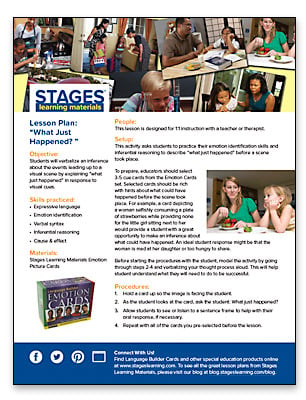What Just Happened?
Lesson Overview
Students will verbalize an inference about the events leading up to a visual scene by explaining “what just happened” in response to visual cues.
Objectives/Goals
- Expressive language
- Emotion identification
- Verbal syntax
- Inferential reasoning
- Cause & effect
Materials
Stages Learning Materials Language Builder: Emotion Cards
People
This lesson is designed for 1:1 instruction with a teacher or therapist.
Setup
This activity asks students to practice their emotion identification skills and inferential reasoning to describe “what just happened” before a scene took place.
To prepare, educators should select 3-5 cue cards from the Emotion Cards set. Selected cards should be rich with hints about what could have happened before the scene took place. For example, a card depicting a woman selfishly consuming a plate of strawberries while providing none for the little girl sitting next to her would provide a student with a great opportunity to make an inference about what could have happened. An ideal student response might be that the woman is mad at her daughter or too hungry to share.
Before starting the procedures with the student, model the activity by going through steps 2-4 and verbalizing your thought process aloud. This will help student understand what they will need to do to be successful.
Procedures
- Hold a card up so the image is facing the student.
- As the student looks at the card, ask the student: How does he/she feel at work?
- Allow students to see or listen to the sentence frame to help with their oral response.
- Repeat with all of the cards you pre-selected before the lesson.
Additional Suggestions for Support
-
Visual sentence frames - Before engaging in the activity, create an “anchor chart,” or referenceable visual aid, with sentence stems that students can use to respond to your questions. Remember to review the sentence stems and model correct usage before engaging in the activity!
-
Provide choices - Should students struggle to identify what is taking place in the photo (emotion, occupation, noun, situation), remember that choices can provide additional support without “giving away” the answer. For example, if a student is unable to identify an emotion as “happy,” consider asking the student, “Is the person in the picture feeling sad?”
-
Echoing answers - If students are struggling to generate language to respond to your prompt, consider having students echo the correct answer by repeating after you. State the correct answer in 2-3 word phrases and ask the student to repeat after you. To increase difficulty, extend the length of repeated phrases. Remember to celebrate successes!
-
Meaningful motion - Incorporate physical gestures and movements to help students understand and generate language. Encourage students to mirror your movements in their responses.
-
Pre-teach vocabulary - Before your activity, don’t forget to pre-teach essential vocabulary to ensure students are equipped with the language required for success. Show students a visual image that represents the word and ask them to say the word after you. This support is especially important for language learners.
- Response drawings - Invite students to draw their responses instead of speaking them aloud as a way to help initiate the process of communication. After students have produced a drawing, prompt them to explain their creation by asking probing questions.

Grace Chen
Grace Chen is currently pursuing an Ed.M. in Arts in Education at Harvard Graduate School of Education. She has been a teaching artist, curriculum developer, and research assistant focusing on innovative evaluations in out-of-school time programs. She hopes to develop resonant and empowering art programs by partnering with youth in educational research and practice.






